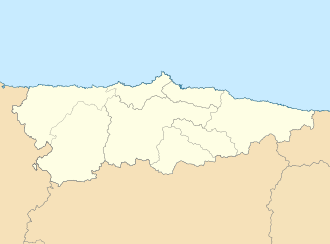Alto de Angliru
| Alto de Angliru | |||
|---|---|---|---|
|
View of El Angliru from Monsacro |
|||
| Compass direction | North | southeast | |
| Pass height | 1570 msnm | ||
| Autonomous community | Asturias | ||
| expansion | Mountain road | ||
| profile | |||
| Ø pitch | 7.9% (1403 m / 17.7 km) | 9.9% (1248 m / 12.55 km) | |
| Max. Incline | 23.5% (on km 16) | 23.5% | |
| Map (Asturias) | |||
|
|
|||
| Coordinates | 43 ° 13 '17 " N , 5 ° 56' 32" W | ||
The Alto de Angliru is a very steep mountain climb in Asturias , northwestern Spain . Due to its steepness, it is one of the most difficult in cycling .
The highest point of the road is 1570 meters above sea level. Up to this point, 1258 vertical meters are covered over a distance of 12.55 kilometers. This means that the route has an average gradient of 9.9 percent. After the first five kilometers with an average gradient of 7.6 percent, there is a flat section with just 2 percent gradient. Up to this point the ascent does not stand out from other climbs that are climbed in cycling.
The second half of the ascent, on the other hand, is unusually difficult. This used to be a cattle path and was paved especially for the Vuelta a España in the mid-90s . This half has an average gradient of 13 percent, with 23.6 percent on one ramp, the so-called Cueña les Cabres , and about 20 percent each on two other ramps. This makes the Alto de Angliru one of the most extraordinary mountain arrivals in cycling. So that the racing drivers can even climb the Alto de Angliru, the bikes are equipped with a special transmission. Even a mountain specialist like Fernando Escartín had to get off the saddle on his first climb, but during training. During the Vuelta he conquered the mountain with a gear ratio of 32/23.
The organizers of the Vuelta a España were looking for a mountain finish that could keep up with the big mountain finishes of the Tour de France such as L'Alpe d'Huez or Mont Ventoux and included Alto de Angliru in the program for the first time in 1999 .
The winner of this stage was José María Jiménez . The increase was then six more times in the program of the Vuelta a España, in 2000 (winner: Gilberto Simoni ), 2002 (winner: Roberto Heras ), 2008 (winner: Alberto Contador ), 2011 (winner: Juan José Cobo ), 2013 (winner: Kenny Elissonde ) and 2017 (winner: Alberto Contador).
Web links
- Incline profile (north) - 17.7 km / 7.9%
- Gradient profile (southeast) - 12.55 km / 9.9%

